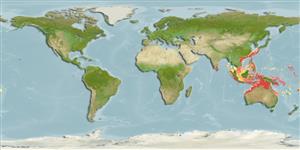Environment: milieu / climate zone / depth range / distribution range
Écologie
marin benthopélagique; profondeur ? - 146 m (Ref. 58018). Tropical; 32°N - 25°S
Western Pacific: Western Australia from Koks Island, Shark Bay northwards to Cape Talbot; Japan from Kochi Prefecture, Ryukyu Islands southwards and along the north China coast to Taiwan and Viet Nam.
Taille / Poids / Âge
Maturity: Lm ? range ? - ? cm
Max length : 55.0 cm TL mâle / non sexé; (Ref. 45251); common length : 35.0 cm TL mâle / non sexé; (Ref. 27621); poids max. publié: 2.5 kg (Ref. 3132)
Épines dorsales (Total): 8; Rayons mous dorsaux (Total): 11; Épines anales 3; Rayons mous anaux: 9. One dark vertical band through eye which may disappear with an increase in size; 11 dorsal fin rays and 9 anal fin rays. Supraclavicle not developed into a bony shield. Peritoneum and gill rakers black; lateral line with 49 to 51 pored scales; juveniles with narrow horizontal bands narrower than interspaces.
Inhabit trawling grounds. Found in moderate depths on the continental shelf, particularly close to reefs or rough bottoms. Carnivorous. Marketed fresh and salted (Ref. 27621).
Life cycle and mating behavior
Maturité | Reproduction | Frai | Œufs | Fécondité | Larves
McKay, R.J., 1997. FAO Species Catalogue. Vol. 17. Pearl perches of the world (family Glaucosomatidae). An annotated and illustrated catalogue of the pearl peches known to date. FAO Fish. Synop. 125(17):26p. Rome: FAO. (Ref. 27621)
Statut dans la liste rouge de l'IUCN (Ref. 130435)
Menace pour l'homme
Harmless
Utilisations par l'homme
Pêcheries: intérêt commercial mineur
Plus d'informations
Noms communsSynonymesMétabolismePrédateursÉcotoxicologieReproductionMaturitéFraiRassemblement de ponteFéconditéŒufsDéveloppement de l'œuf
RéférencesAquacultureProfil d'aquacultureSouchesGénétiqueElectrophoresesHéritabilitéPathologiesTraitementNutrientsMass conversion
CollaborateursImagesStamps, Coins Misc.SonsCiguateraVitesseType de nageSurface branchialeOtolithesCerveauxVision
Outils
Articles particuliers
Télécharger en XML
Sources Internet
Estimates based on models
Preferred temperature (Ref.
123201): 24.2 - 28.8, mean 27.6 °C (based on 776 cells).
Phylogenetic diversity index (Ref.
82804): PD
50 = 0.6250 [Uniqueness, from 0.5 = low to 2.0 = high].
Bayesian length-weight: a=0.02399 (0.01804 - 0.03189), b=2.89 (2.80 - 2.98), in cm total length, based on LWR estimates for this species (Ref.
93245).
Niveau trophique (Ref.
69278): 4.2 ±0.5 se; based on size and trophs of closest relatives
Résilience (Ref.
120179): Faible, temps minimum de doublement de population : 4,5 à 14 années (tmax=26; k=0.13).
Fishing Vulnerability (Ref.
59153): High vulnerability (57 of 100).
